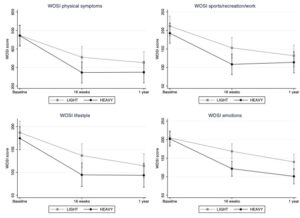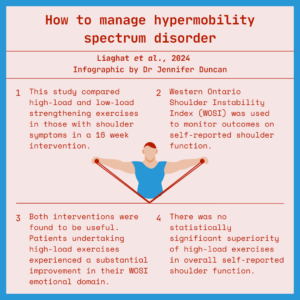Why is this study important?
Clinicians managing patients with hypermobility spectrum disorder (HSD) and shoulder symptoms constantly seek evidence-based approaches for effective interventions. This study directly addresses the comparison between high-load and low-load strengthening exercises, presenting valuable insights that can inform clinical decision-making and treatment strategies and summarises a recently published study (1).
How did the study go about this?
Conducting a randomized trial involving 100 adults with HSD and shoulder pain, the study assigned participants to two groups: one engaged in high-load exercises and the other in low-load exercises performed three times weekly over a 16-week intervention period. At one-year follow-up, we monitored outcomes using the Western Ontario Shoulder Instability Index (WOSI) and other relevant measures, ensuring a comprehensive assessment of self-reported shoulder function.
What did the study find?
One year of data from 86 participants showed no statistically significant superiority of high-load exercises over low-load exercises in overall self-reported shoulder function. However, a noteworthy discovery emerged concerning the emotional dimension. Patients undertaking high-load exercises experienced a more substantial improvement in the WOSI emotions subdomain. Moreover, the patient-perceived effect favoured the high-load group, particularly in domains related to emotions and lifestyle. These findings suggest that, while high-load exercises may not be superior in functional outcomes, they appear to offer specific emotional benefits.

Figure 1: WOSI domains
What are the key take-home points?
- Given the lack of clear superiority in overall shoulder function, clinicians should consider tailoring exercise prescriptions based on individual patient needs and preferences. High-load exercises may be particularly beneficial for addressing emotional aspects related to shoulder issues.
- The study highlights the importance of considering the emotional impact of exercises on patients. Clinicians should incorporate discussions about emotional well-being when developing treatment plans, recognizing the interconnected nature of physical and emotional aspects in managing chronic conditions.
- Clinicians should stay informed about emerging research in this area. As the study emphasizes the need for more robust data, staying updated on subsequent studies can refine and enhance treatment recommendations.
In conclusion, this study is a valuable resource for clinicians dealing with patients with HSD and shoulder symptoms. While high-load exercises may not exhibit superiority in overall shoulder function in the long term, their potential to positively impact patients’ emotional well-being makes them noteworthy in individualized treatment plans. Further research is essential for refining and solidifying these findings.

References:
- Liaghat B, Juul-Kristensen B, Faber DA, et al One-year effectiveness of high-load compared with low-load strengthening exercise on self-reported function in patients with hypermobile shoulders: a secondary analysis from a randomised controlled trial British Journal of Sports Medicine Published Online First: 22 January 2024. doi: 10.1136/bjsports-2023-107563
Authors: Behnam Liaghat